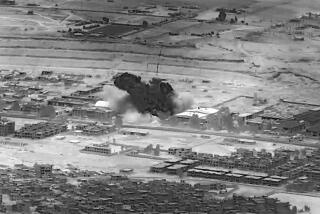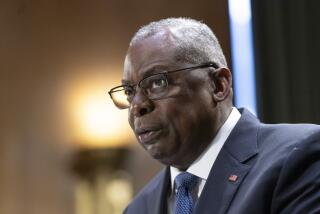U.S. Military Facing Terror of Chemical War
- Share via
WASHINGTON — As U.S. Army forces take up positions in the Saudi Arabian desert, each soldier wears two awkward adornments strapped firmly to his thigh: a gas mask and a needle tinged with medicine. They are standard-issue antidotes for the horror of chemical war.
Absent from American combat since World War I, the threat of poison gas now lingers over the Middle East in a looming battle over oil. According to war planners and outside experts, it could raise major complications for the U.S. mission in the region.
Iraqi President Saddam Hussein used nerve gas in his eight-year war against Iran and chemical weapons against rebels in Iraq. Whether he actually would risk an American counterblow by unleashing the weapons again remains a topic of dispute.
But analysts warned that Hussein’s capacity to play the chemical card will further hinder U.S. forces in an already hostile theater, requiring them at times to don rubber protective gear in already unyielding heat.
“The whole object of chemical war is to degrade the other side’s performance,” one intelligence official said. “In the desert, the threat alone may degrade U.S. troops from the start.”
With proper precautions, the analysts said, the current contingent of elite American ground personnel confined to airfield duty probably could escape serious harm in the event of a first-strike Iraqi attack.
But they warned that an expected American escalation--and particularly any step to dispatch infantry forces to positions near or across enemy lines--could find itself bogged down by the overarching need to guard against chemical attack.
Despite a $9-billion U.S. effort aimed at fending off poison gas attack, experts express agreement that such a task remains “extraordinarily difficult,” in the words of former Defense Secretary Caspar W. Weinberger.
And the problem is compounded by an adversary like Hussein, whose history reflects a willingness to use chemicals not merely in desperation but as a calculated instrument of attack. For Hussein, said Rep. Les Aspin (D-Wis.), chairman of the House Armed Services Committee, chemical warfare represents “an ace in the hole.”
Gen. Colin L. Powell, chairman of the Joint Chiefs of Staff, emphasized Wednesday that U.S. soldiers in Saudi Arabia are well-equipped and well-trained in the protective tactics designed to survive a chemical attack, even in searing desert heat.
But he also acknowledged grimly that still-ambiguous intelligence reports of Iraqi commanders distributing chemical weapons to their troops are being taken very seriously. “It’s a threat we’re concerned with,” Powell said. “I treat it as a capability that is there to be used.”
The prospect of chemical war has been high on the minds of U.S. military planners for more than a decade, and rapid-deployment units like those dispatched to the Saudi desert have practiced poison-gas scenarios in war games in the Mojave Desert and in Egypt.
Such operations have become more intensive with growing concern about an Iranian or Iraqi threat. And amid heat, sand and other desert hardships, they represent the best rehearsal for current operations.
But periodic assessments by government investigators and intelligence officials repeatedly have concluded that the devastating properties of chemicals as arms still leave American forces threatened. Indeed, midway through the U.S. chemical defenses buildup, the General Accounting Office concluded bluntly in 1986 that American defenses were inadequate.
Among those the government auditors found to be particularly at risk: Navy ships at sea and command posts on the ground--and the rapid-deployment troops like the 82nd Airborne, operating in the open with only light equipment.
Military officials said Wednesday that each of the U.S. soldiers dispatched to the Middle East is carrying a Mark I combat kit containing atropine, an injectable common drug that serves as an antidote to the effects of nerve gas--perhaps Hussein’s most potent threat.
The needle-ready kit, worn strapped tight across the thigh, is designed to provide emergency aid to a soldier who comes under surprise nerve gas attack. A hard slap to the thigh sends atropine into the victim’s system, serving as a muscle relaxant.
They also carry so-called MOPP kits--the heavy charcoal-lined suits whose mask and head-to-toe cover provide the only guarantee of safety against a chemical attack. An acronym for military operational personnel protection, MOPP suits are “hot as blazes” in even temperate heat, according to former a soldier who has worn them.
“If you had to wear one in a desert situation,” the former soldier said, “I don’t think you could last more than an hour.”
According to military sources, the “ready brigade” of some 4,000 paratroopers from the 82nd Airborne also includes a special company designed to combat the effects of chemical war. The unit carries special devices to detect the presence of poison gases and would seek to decontaminate men and their equipment.
The desert heat would also hamper an Iraqi chemical attack, because poison agents would dissipate more quickly. But analysts said that the hot-weather burden on American ground troops would be far more severe, in part because Hussein could overcome evaporation by increasing his chemical attack.
CIA estimates recently provided to Congress show that Iraq has amassed a vast stockpile containing as much as several thousand tons of chemical weapons, including both nerve and mustard gas.
Iraqi forces used the chemicals with increasingly devastating effect in its eight-year war with Iran, escalating from purely defensive use of the weapons to gas-bombings and shellings to open the way for major ground attacks.
Nerve gas, generally used in aerosol form, attacks the nervous system of its victims by inhibiting the normal action of a body enzyme. Difficult to detect, it poses severe dangers from inhalation and from contact. In severe cases it results in convulsion, coma and--unless properly treated--death.
Mustard gas is a liquid agent whose blistering power and other horrors became part of the numbing history of World War I. With effects that can last for hours, it has no antidote other than staying out of its way.
Because Hussein has used explosives and poison gases on civilians, American analysts expressed uncertainty about where he might aim an anti-American chemical attack.
And because U.S. chemical weapons already may have been shipped to the region--and the United States, unlike Iran, also maintains potentially overpowering weaponry--many of the analysts expressed doubt as to whether Hussein would take the risk of opening a chemical war.
“I’m not convinced that Saddam Hussein is going to use chemical weapons,” said Elisa Harris, a Brookings Institution expert. “He must recognize that that would be suicidal.”
But the experts said it was conceivable that the Iraqi leader might use gas, firing bombs or shells at ground troops or attacking ships at sea.
They said such an overarching threat could impose severe limits to U.S. forces, particularly on the desert floor, a world where blowing sand can wreak havoc on aircraft engines and 110-degree heat creates a need in man for six gallons of water a day.
“You have to add the morale factor that chemical weapons seem to bring,” said Steve Bowman, a congressional weapons expert with the Congressional Research Service. “It makes for a very high anxiety factor.”
Staff writers Melissa Healy, Thomas B. Rosenstiel and Karen Tumulty contributed to this report.
KEY U.S. WARPLANES IN GULF CRISIS F-111:
Type: Tactical fighter-bomber.
Primary Purpose: Ground-hugging “penetration” missions to surgically remove specific enemy positions.
Combat radius: About 1,600 miles.
Armament: Equipped with 20-millimeter cannon and a variety of rockets, including air-to-air and air-to-ground missiles.
Capabilities: Can carry about 17,000 pounds of bombs and other weapons.
Miscellaneous: At least 14 on training maneuvers at Incirlik air base in Turkey. F-111s were deployed from bases in Britain in
U.S. raid on Libya in 1986.
F-16:
Type: Fighter and ground attack aircraft.
Primary purpose: Close air support. All-weather navigation ability.
Combat radius: 575 miles.
Armament: Equipped with 20-millimeter cannon. Typical weapons include two wingtip-mounted Sidewinders with up to four more on the outer underwing stations.
Capabilities: Can carry 12,000 pounds of bombs and other weapons. Air-to-air combat with gun and Sidewinders; air-to-ground attack with gun-rockets, conventional bombs, laser-guided weapons.
Miscellaneous: The U.S. Air Force has 1,083 on active duty.
Available but not yet deployed to gulf region.
F-15:
Type: “Air superiority” fighter also capable of ground attack.
Primary purpose: Long-range penetration by day or night.
Combat radius: 790 miles.
Armament: Equipped with 20-millimeter cannon and a variety of air-to-air weapons over short and medium ranges, including four Sidewinders and four Sparrows. Can carry a variety of guided and unguided air-to-ground weapons.
Capabilities: Can carry 24,500 pounds of bombs and other weapons.
Miscellaneous: About 20 deployed from the 1st Tactical Fighter Wing at Langley Air Force Base in Virginia, bound for base in northern Saudi Arabia.
A-6:
Type: Carrier-borne, low-level attack plane.
Primary purpose: An all-weather plane equipped with sophisticated electronic gear; can seek out and destroy targets at night and in bad weather.
Combat Radius: 1,100 miles.
Armament: Typical weapon loads are 28 500-pound bombs. Can carry Sidewinders for air-to-air use as well as anti-ship missiles.
Capabilities: Can carry a bomb load of 18,000 pounds.
Miscellaneous: 340 in the U.S. naval fleet; each aircraft carrier has 20.
Sources: Times staff writers and Jane’s All the World’s Aircraft
More to Read
Sign up for Essential California
The most important California stories and recommendations in your inbox every morning.
You may occasionally receive promotional content from the Los Angeles Times.













